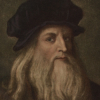Leonardo da Vinci

Leonardo da Vinci
Leonardo di ser Piero da Vinci, more commonly Leonardo da Vinci or simply Leonardoˈvintʃi] ; 15 April 1452 – 2 May 1519), was an Italian polymath whose areas of interest included invention, painting, sculpting, architecture, science, music, mathematics, engineering, literature, anatomy, geology, astronomy, botany, writing, history, and cartography. He has been variously called the father of paleontology, ichnology, and architecture, and is widely considered one of the greatest painters of all time. Sometimes credited with the inventions of the parachute, helicopter and tank,...
NationalityItalian
ProfessionPainter
Date of Birth15 April 1452
CityVinci, Italy
CountryItaly
The vine that has grown old on an old tree falls with the ruin of that tree, and through that bad companionship must perish with it.
To speak ill of a good person is not truly good, all in all.
Nature is the source of all true knowledge. She has her own logic, her own laws, she has no effect without cause nor invention without necessity.
If you put on more clothes as the cold increases, it will have no power to hurt you. Let us hope that.
If we make mistakes in our first compositions and do not know them, we may not amend them.
O Time with your teethy years! You swallow up all things little by little in a slow-motion, wrinkling process of dying.
Old age takes in part savoury wisdom for its food - see to that your old age will not lack in nourishment.
We may call painting the grandchild of nature.
Anyone who invokes authors in discussion is not using his intelligence but his memory.
O speculators about perpetual motion, how many vain chimeras have you created in the like quest? Go and take your place with the seekers after gold.
Though I may not . . . be able to quote other authors, I shall rely on that which is much greater and more worthy - on experience.
Some promises and time disappoint us
Necessity is the mistress and guide of nature. Necessity is the theme and inventress of nature, her curb and her eternal law.
I say that in narrative paintings one should mingle direct contraries close by, because they produce strong contrasts with one another, and all the more so when they are very close together; that is, the ugly next to the beautiful, the big to the small, the old to the young, the strong to the weak; in this way you will vary as much as possible and close by.